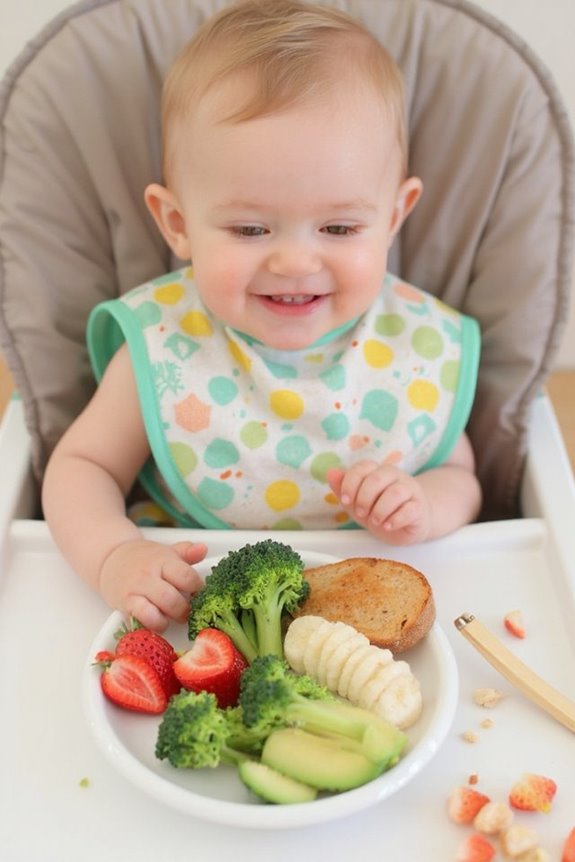Baby-led weaning is an approach where infants feed themselves solid foods from around 6 months, skipping traditional purees. Your baby should be able to sit upright, have good head control, and show interest in food before starting. Offer soft, finger-sized pieces of nutritious foods like steamed vegetables, ripe fruits, and protein sources. Always supervise mealtimes and learn to distinguish between gagging (normal) and choking (requires intervention). The following safety guidelines will help you navigate this exciting developmental milestone.
Key Takeaways
- Baby-led weaning allows infants to self-feed appropriate foods beginning around 6 months when developmental readiness signs appear.
- First foods should be soft, easy-to-grasp pieces like steamed vegetable strips, ripe fruit slices, and moist protein sources.
- Always supervise mealtimes, ensure proper seating position, and avoid high-choking-risk foods like whole grapes and nuts.
- BLW encourages self-regulation of hunger, potentially reduces picky eating behaviors, and develops strong oral motor skills.
- Including babies in family mealtimes promotes positive food associations and creates a foundation for lifelong healthy eating habits.
What Is Baby-Led Weaning? Core Principles Explained
While traditional weaning often involves spoon-feeding purees, baby-led weaning (BLW) takes a fundamentally different approach to introducing solid foods. This baby led introduction method empowers infants to feed themselves from the start, typically beginning around 6 months when developmental readiness indicators appear.
The core principles of BLW include:
- Independence at mealtimes through self feeding techniques
- Offering food in easy-to-grasp pieces rather than purées
- Allowing babies to explore taste, texture, and smell at their own pace
- Including babies in family mealtimes
- Respecting your baby’s appetite and eating cues
BLW supports oral motor development as babies learn to manage different textures, developing strong chewing and swallowing skills naturally. The approach emphasizes responsive feeding—watching and responding to your baby’s hunger and fullness signals.
Signs Your Baby Is Ready to Start Solids
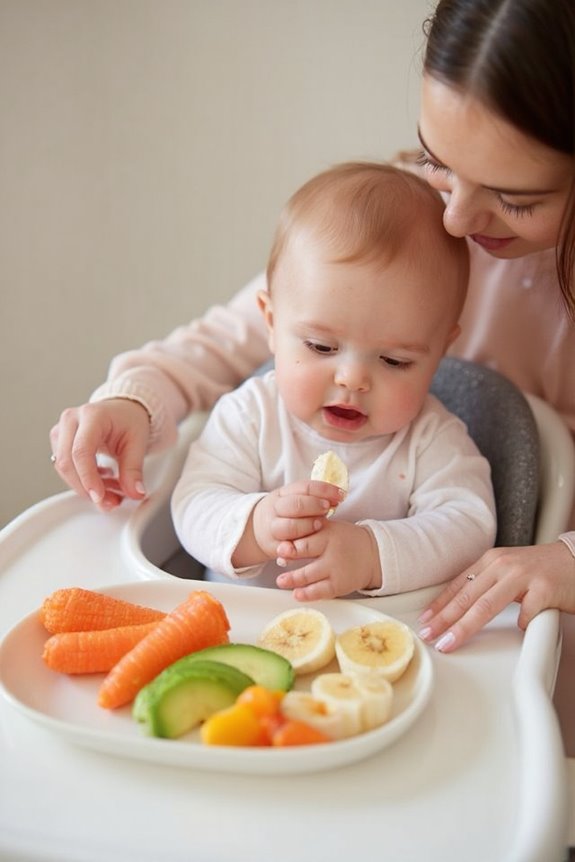
Before you begin baby-led weaning, you’ll need to confirm your little one is physically ready for solid foods. Developmental readiness typically emerges around 6 months of age, but varies with each child.
Look for these key feeding cues:
- Your baby can sit upright without support
- Good head and neck control is established
- The tongue-thrust reflex has disappeared
- They’ve developed a pincer grasp to pick up food
- They show interest in what you’re eating
I recommend waiting until all these signs are present rather than starting based solely on age. For premature babies, readiness may align with their corrected age. Always maintain constant supervision during meals and avoid high-risk choking foods as your baby explores this exciting new phase.
Getting Started: First Foods for Baby-Led Weaning
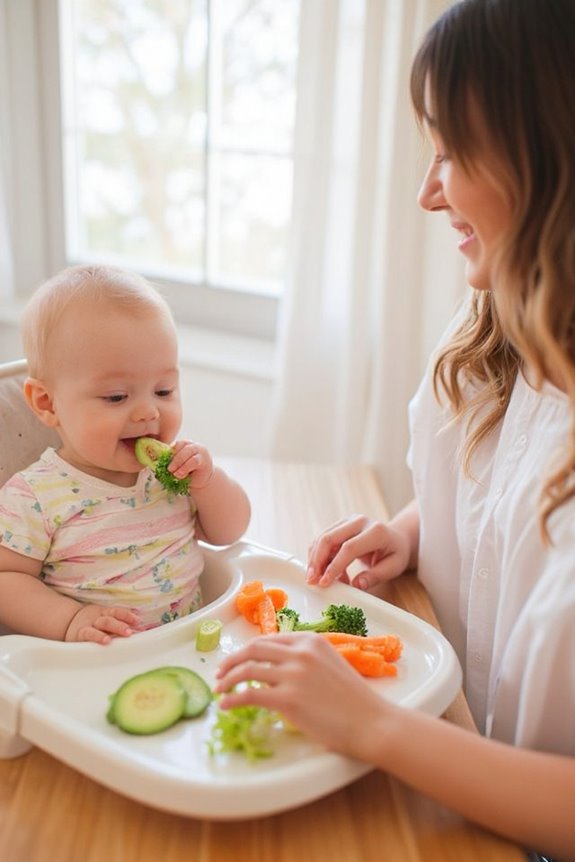
Once your baby shows all the readiness signs, it’s time to introduce their first solid foods through baby-led weaning. When selecting first food recommendations, focus on nutrient-rich options that are easy to grasp and soft enough to reduce choking hazards.
Consider these starter foods:
- Steamed vegetable strips (broccoli, sweet potato)
- Soft fruit pieces (ripe banana, avocado slices)
- Protein sources like moist salmon flakes or scrambled eggs
- Lightly toasted bread fingers
Introducing textures gradually helps your baby develop important oral motor skills. I recommend offering a variety of consistencies, from soft to slightly firmer foods as they progress. Always supervise mealtimes and make certain food pieces are finger-sized—large enough for your baby to hold with some sticking out of their fist.
Safety First: Minimizing Choking Risks
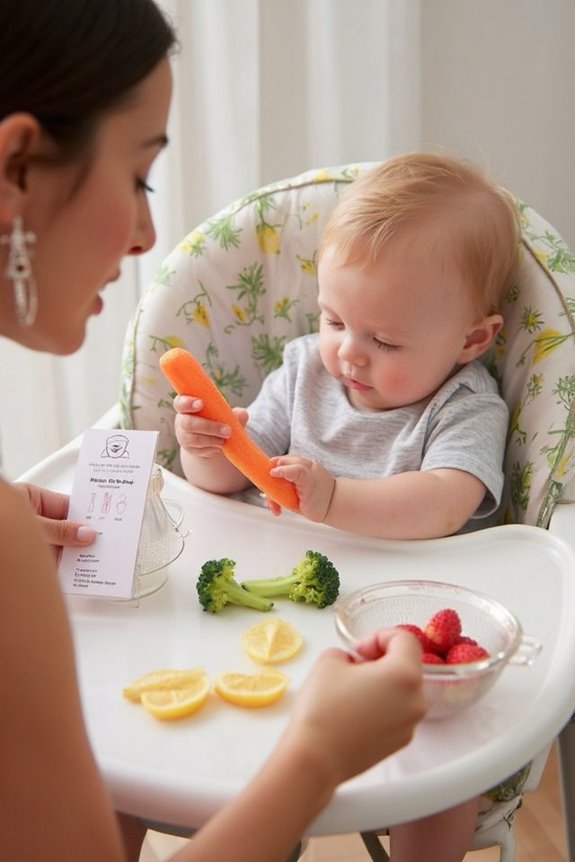
Safety concerns often top the list for parents considering baby-led weaning. While research shows that baby-led weaning doesn’t notably increase choking risks compared to traditional methods, proper precautions remain essential.
Choking Prevention Essentials:
- Always supervise your baby during meals
- Guarantee proper seating position (upright, supported)
- Learn infant first aid techniques
- Create a distraction-free eating environment
Key Food Modifications:
- Avoid round, hard foods like whole grapes and nuts
- Cut foods into finger-sized pieces (not coin-shaped)
- Steam hard vegetables until slightly soft
- Avoid high-risk items like popcorn and hard candy
I recommend preparing foods to the right consistency—soft enough to squish between your fingers but firm enough for your baby to grasp. With proper food modifications and vigilant supervision, baby-led weaning can be a safe approach to introducing solids.
The Difference Between Gagging and Choking
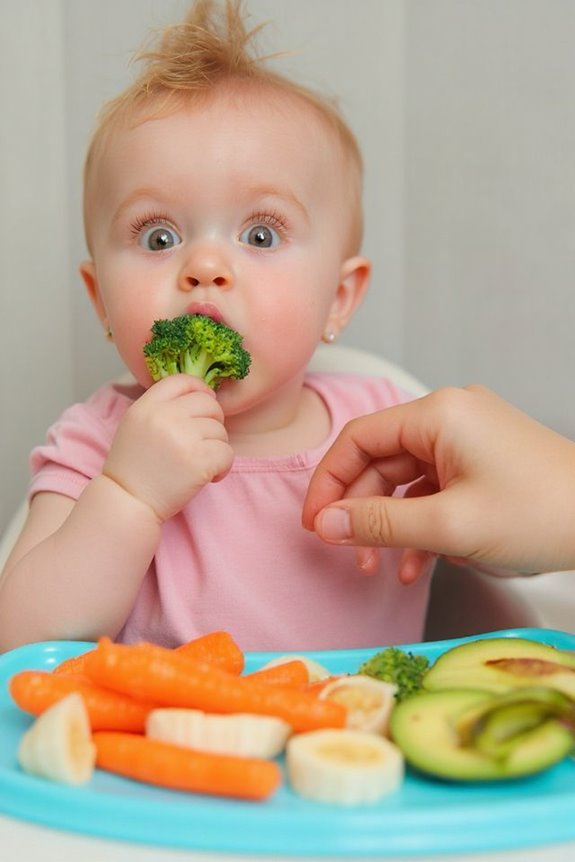
Many parents struggle to distinguish between gagging and choking, which can lead to unnecessary panic during mealtimes.
The gagging reflex is a natural safety mechanism that helps babies learn to manage food. It’s characterized by:
- Loud coughing or gurgling sounds
- Brief pauses in breathing that quickly resume
- The ability to push food forward in the mouth
In contrast, choking signs include:
- Silent struggling
- Inability to breathe
- Possible bluish color changes
- Complete airway obstruction
When your baby gags, resist the urge to intervene—they’re learning! Position yourself calmly beside them to provide support. Remember that gagging is common as babies explore new textures, while true choking is rare. Understanding this distinction will help you respond appropriately and make mealtimes less stressful for everyone.
Essential Equipment for Successful Mealtimes
Setting up your kitchen with the right tools isn’t just convenient—it’s essential for safe and enjoyable baby-led weaning.
High Chair Features
- Choose a stable high chair with proper support for ideal positioning
- Verify it has easy-to-clean surfaces
- Look for adjustable height options
Mealtime Mess Management
- Invest in long-sleeved bibs that wipe clean easily
- Place splash mats under the high chair
- Keep multiple washcloths handy
I recommend the ezpz Tiny Cup for drinking practice—it’s weighted at the bottom for stability. Pair this with suction plates and chunky-handled spoons to help your baby gain independence while eating. Remember that all feeding equipment should be BPA-free and dishwasher-safe for convenient sanitizing.
Nutritional Considerations and Balanced Meals
While your baby explores new textures and flavors through baby-led weaning, ensuring they receive proper nutrition remains your top priority. I recommend focusing on nutrient density by including a balance of carbohydrates, proteins, and healthy fats in each meal.
When planning your baby’s meals, consider:
- Starting with savory foods before sweet ones
- Including steamed vegetables like broccoli and spinach
- Offering well-cooked proteins such as chicken and beans
- Adding energy-rich carbohydrates like sweet potatoes
Meal variety is essential for providing diverse nutrients. Gradually introduce common allergens in small amounts, monitoring for any reactions. Keep a food diary to track new introductions and potential sensitivities.
Minimize added salt and sugar, focusing instead on natural flavors. Remember to prepare foods in appropriate sizes to prevent choking hazards.
Common Challenges and How to Overcome Them
Despite a solid nutritional foundation, baby-led weaning comes with several challenges that parents often encounter. Choking awareness is essential, though studies show BLW doesn’t necessarily increase choking risks compared to traditional methods. Still, about 12.3% of children experience choking incidents during BLW.
To address this challenge:
- Always supervise meals completely
- Learn proper meal preparation techniques—cut food into large, soft pieces
- Know basic infant CPR
- Recognize the difference between gagging (normal) and choking (emergency)
Other common issues include:
- Gagging (occurs in 51.9% of cases)
- Spitting out food (77.1% of cases)
- Nutritional concerns, particularly iron and zinc intake
- Parental anxiety during mealtimes
Consulting healthcare providers and joining support networks can markedly reduce these challenges while maintaining BLW’s benefits.
Long-Term Benefits for Your Child’s Relationship With Food
As your baby grows into a toddler and beyond, the eating habits established during weaning can greatly impact their relationship with food for years to come. Baby-led weaning promotes several long-term benefits:
- Self-regulation: Children learn to honor their hunger and fullness cues naturally
- Reduced food fussiness: Early food exploration with various textures and flavors may decrease picky eating behaviors
- Healthy eating patterns: Family mealtime involvement encourages children to eat a wider variety of foods
- Positive food associations: When children participate in mealtimes from an early age, they develop a more relaxed attitude toward eating
Research suggests BLW children may have a lower risk of excess weight gain, though studies show mixed results. The approach aligns with higher rates of breastfeeding, potentially reducing risks of allergies and chronic diseases later in life.
Frequently Asked Questions
How Do Grandparents and Caregivers Adapt to Baby-Led Weaning?
I’ve found that grandparent involvement often requires education about BLW’s benefits and safety. Caregiver support improves when I demonstrate proper techniques and explain how this approach promotes independence and healthy eating habits.
Can Babies With Developmental Delays Participate in BLW?
Despite common hurdles, I believe babies with developmental delays can shine with BLW! I recommend focusing on developmental considerations and implementing adaptive strategies, like modified seating or specialized utensils, always under professional guidance.
How Does BLW Work in Different Cultural Food Traditions?
I’ve found BLW works beautifully across cultures through cultural adaptations of traditional foods. You can offer your baby finger-sized portions of your family’s cultural dishes, making mealtime a shared cultural experience.
What Impact Does BLW Have on Family Mealtimes?
I’ve found BLW transforms family dynamics completely! You’ll eat together more often, establish consistent mealtime routines, and create a more relaxed atmosphere. Plus, you’re saving time by preparing just one meal for everyone.
How Do You Handle BLW in Restaurants or When Traveling?
Afraid of the mess? I’ve mastered restaurant strategies by bringing portable high chairs and splash mats. When traveling, I pack essentials, communicate with servers about speedy service, and choose baby-friendly foods. It’s surprisingly manageable!

